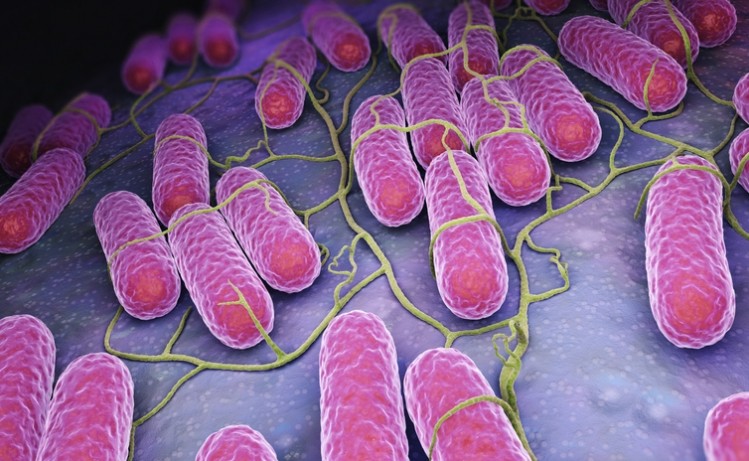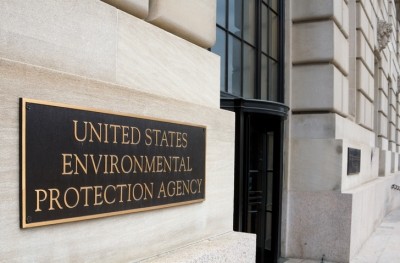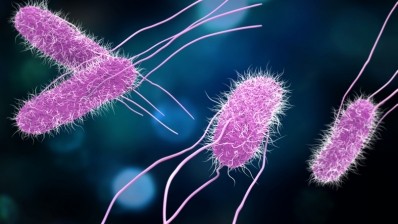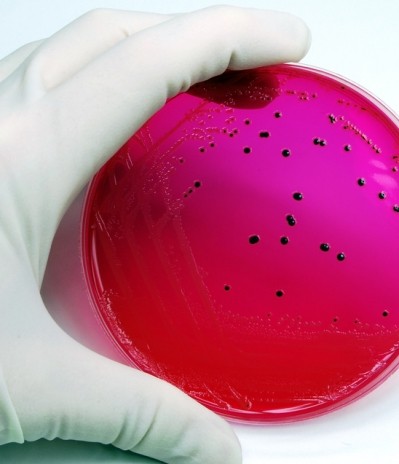Study finds sequencing and dry sanitizers can aid Salmonella control in US feed mills

The objective of the study, led Dr Professor Cassandra Jones, associate professor, Department of Animal Sciences & Industry, Kansas State University, was to evaluate the efficacy of flushing surfaces with untreated feed vs. the use of two different dry chemical sanitizers on residual surface and feed Salmonella Enteritidis contamination.
“This study demonstrated how animal food manufacturing surfaces can be contaminated with Salmonella Enteritidis after manufacturing a Salmonella-positive batch of poultry feed. It is possible for contaminated surfaces to then subsequently adulterate succeeding feed batches.
“The use of sequencing and using chemically-treated flush material may help reduce this potential. Additional research is necessary to further evaluate the role of sequencing and dry sanitizers when Salmonella biofilm are formed on manufacturing surfaces,” wrote the researchers in the paper published in Poultry Science.
The proprietary medium chain fatty acid (MCFA) blend and the commercially-available dry essential oil blend used in this experiment showed promise to reduce the numerical quantity of detectable Salmonella in animal feed or on surfaces when they were included as flushes, added the team.
Sanitation in US feed mills
Recent changes in US regulation and customer requirements are placing new pressure on the sanitation expectations for feed manufacturing facilities, noted the researchers.
Previous methods of sanitation of feed contact surfaces have relied on ‘sequencing’, where diets are manufactured in a strategic sequence to limit carryover from high risk ingredients to specific feeds, and ‘flushing,’ where a pulse of feed is conveyed through the manufacturing system to ‘flush’ hazards through the manufacturing system, they explained.
“While this method is successful for reducing the risk of chemical hazard carryover, there is limited research that evaluates if the same methods are effective at removing biological hazards from feed manufacturing surfaces, particularly those that form biofilms resistant to physical cleaning,” wrote Dr Jones et al.
With higher emphasis on animal food safety extended to livestock species, feed mills will now need to reevaluate hazards within their facility to determine if hazard control is necessary, they said.
“Most facilities will deem Salmonella spp. to not require such control due to a combination of low severity and probability in animal food.
“However, Salmonella Enteritidis is known to be potentially pathogenic to poultry and the serotype is the 11th most frequent serotype found in animal food (FDA, 2013; Li et al., 2012).
“Thus, some poultry feed manufacturers may determine the control of Salmonella Enteritidis is necessary to prevent animal food from serving as a potential vector of the hazard,” noted the researchers.
Methods to control biological hazards include Current Good Manufacturing Practices (cGMP), process controls, supply-chain-applied controls, or sanitation controls. Sanitation controls are appropriate in cases where an animal food manufacturing facility has concerns with undesirable microorganisms that may contaminate feed through cross-contamination from manufacturing surfaces, said the team.
“While a great quantity of data has been generated regarding the efficacy of sanitizers in human food manufacturing facilities, very little data exists to evaluate the efficacy of sanitizers with animal food. Therefore, the objective of this experiment was to evaluate the efficacy of flushing surfaces with untreated feed vs. the use of two different dry chemical sanitizers on residual surface and feed Salmonella Enteritidis contamination.”
Salmonella presence in US feed mills
Pathogen presence in feed mills can represent one of the many potential routes for entry and transmission into the food production chain. Nevertheless, little is known about Salmonella incidence and association with these types of environments, according to researchers in an earlier study. Its objective was to investigate Salmonella presence in different feed mills across the US.
The team involved in that study selected 11 facilities in eight states and 12 sites were sampled within each feed mill. Samples were analyzed following the FSIS guidelines for isolation and identification of Salmonella. Positive isolates were further investigated by a PCR analysis targeting the invA gene to differentiate for Salmonella enterica.
The total number of environmental samples collected was 237: 66% resulted culture positive and 13.1% were PCR positive. All sampled feed mills had at least one culture positive site and following production flow the number of positive samples decreased from ingredient receiving to final product.
The authors of that paper said their preliminary results demonstrated the presence of Salmonella in selected US feed mills and suggested their potential role as vehicle for pathogen transmission and spread into the food production chain.
Methodology
The team explained that first, a Salmonella-negative batch of poultry feed was mixed in nine laboratory-scale paddle mixers. A feed sample was collected, and targeted locations on surfaces within the mixer were swabbed to confirm Salmonella-negative. Next, a Salmonella-positive batch of poultry feed was mixed, sampled, and mixer surfaces swabbed.
Mean Salmonella Enteritidis contamination across all nine mixers were 3.63 CFU/g for sampled feed and 1.27 CFU/cm2 for surface contamination, they said.
Next, the mixers manufactured one of the following treatments (three mixers/treatment): 1) none which served as the control; 2) a commercially available eubiotic essential oil blend; or 3) rice hulls treated with a 10% concentration of a propriety blend of medium chain fatty acids (MCFA).
After each treatment, each mixer manufactured another two batches of Salmonella-free feed (Sequence 1 and Sequence 2), said the research team.
Feed samples were collected, and surfaces were swabbed between each batch of feed.
Results
No samples of feed had detectable Salmonella after the Salmonella-negative batch of feed was manufactured, they found. One Salmonella-positive swab was collected from the lid of a mixer after the Salmonella-negative batch was manufactured. This was very low-level contamination, and when averaged with swabs from 11 other swabs from that treatment, the mean level was below the 10 cfu/cm2 detectable limit, said the team.
All samples collected from laboratory-scale mixers after mixing the Salmonella-positive feed were confirmed to be Salmonella-positive, with an average contamination rate of 3.6 log CFU/g, they reported.
The team observed that the contaminated feed increased the contamination of manufacturing surfaces, where 31 of the 36 swabs collected from manufacturing surfaces were positive for Salmonella after manufacturing the Salmonella-positive feed.
“These surfaces were contaminated with a lower quantity of Salmonella than the feed, with mean contamination of 1.3 CFU/cm2 among the 36 samples. It is notable that surfaces had more than a 2-log reduction in Salmonella Enteritidis contamination compared to the level directly in the feed. However, this study effectively demonstrates that Salmonella-positive poultry feed can contaminate animal food manufacturing surfaces and lead to carryover contamination in the next batch.”
After the chemically-treated batch was manufactured, the laboratory-scale mixers were used to mix a Salmonella-negative diet as Sequence 1. In the control mixers, Sequence 1 was mixed immediately after the Salmonella-positive batch, and the team found one feed sample and four surface swabs were still positive for Salmonella after Sequence 1.
“This resulted in a low level of contamination of 0.8 CFU/g and 0.1 CFU/cm2 of Salmonella for feed and manufacturing surfaces, respectively.
“There was also a low level of contamination after manufacturing Sequence 1 in the mixers that had manufactured the chemically-treated batches. One sample of feed and one manufacturing surface of Sequence 1 were positive for Salmonella after Sequence 1 in mixers previously flushed with the commercially-available essential oil blend,” said the researchers.
The feed sample had a Salmonella Enteritidis of 0.7 CFU/g, but mean surface contamination rates were below the 10 CFU/cm2 detectable limit, they added.
None of the feed samples, and four of the manufacturing surface swabs were Salmonella-positive after Sequence 1 in mixers that had previously been flushed with rice hulls treated with 10% MCFA, they found.
Even though four samples were positive, they had a low level of contamination, as the average Salmonella contamination from manufacturing surfaces was 0.1 CFU/cm2, they said.
No feed samples or surface swabs collected after Sequence 2 had detectable Salmonella: “These results indicate that flushing can reduce Salmonella contamination within a mixer, similar to its mechanistic way to reduce drug carryover in medicated feed manufacturing.”
Salmonella control protocol
Dr Frank Jones — professor emeritus, University of Arkansas, in a post on Kemin’s website, said effective Salmonella control programs in the US feed milling sector require continuing attention to detail and sustained effort in three broad areas:
- Preventing contamination from entering the facility
- Reducing microbial multiplication within the plant
- Killing the pathogen
Killing Salmonella in feeds usually involves the application of heat through steam conditioned pelleting or extrusion and/or the addition of chemical inhibitors, he wrote. Controlling Salmonella via steam-conditioned pelleting or extrusion requires:
- Grinding feed ≤ 700 microns
- Total moisture in the conditioned mash of ≥ 15%
- Use of high-quality steam (i.e. ≥ 80%)
- Temperatures of 180-185°F for a minimum of 30 seconds
- Protecting feeds from recontamination
Heat enhances the effectiveness of chemical inhibitors, he said. Chemical inhibitors must be evenly distributed within the feed for maximum effectiveness, added the expert. Chemical inhibitors used in the US are primarily made up of organic acids (mainly formic and propionic acids) or formaldehyde, he added.
Source: Poultry Science
Title: Evaluating the roles of surface sanitation and feed sequencing on mitigating Salmonella Enteritidis contamination on animal food manufacturing equipment
Authors: M Muckey A.R. Huss A. Yoder, C. Jones










